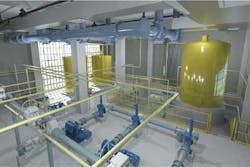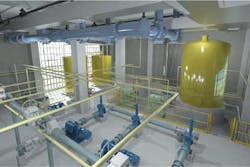By Terry D. Bennett
Arguably, water is the most precious resource we have. Without it, everything — including us and the mechanical systems we design — cease to exist. Water is not an endless resource and its use, like other infrastructure, requires an infrastructure system. And, like most systems based on a natural resource, the natural, physical, and technologically based aspects have to be looked at in unison when we think about the planning, design, construction and operations of water-related systems. This is true whether it is water for drinking, storm collection systems for runoff, or sewer for human waste.
In looking at these systems, we need to understand a multitude of factors: the sources of water and the limits of their use, how to capture and store it, and its treatment, disposal and reuse. We also need to consider how to manage water in periods of overabundance such as storms, or under abundance such as droughts. Additionally, it is important to identify what areas water must service in our cities, whether for consumption, fire protection or other public service obligations. In short, we need to visualize and simulate the intent for water systems long before we bury them for 70 years or longer.
Today, after centuries of overuse, repair, retrofits and inconsistent management, we have maxed out the water systems already in place and we must rethink and re-envision what we will do next to handle the 1.5x global population gain anticipated in the next 35 years.
In total, according to OECD (Organization for Economic Cooperation and Development), society globally will need at least $17.7 trillion for water/wastewater infrastructure over the next 25-30 years. This is happening at a time when local sources of revenues — and even the state-revolving loan funds — are near empty and when other types of infrastructure (roads, bridges, power supply) are competing for what's left. With government revenues continuing to dry up, the only answer is to look at private sector involvement to aid in addressing this escalating issue.
Public Private Partnerships (PPP)
Executing a major infrastructure project from concept to completion, of which water systems certainly qualify, often can take many years, even a decade. This makes it extremely difficult for the public sector to respond to these water infrastructure priorities, given the sharply reduced funding for infrastructure projects as part of local government strategies to deal with budget crises. As a result, we are experiencing a paradigm shift in the way projects are financed.
Public Private Partnerships (PPPs) are one of the few nontraditional options that can help cities and other smaller municipalities address these obligations with the speed required to comply with mandates and increasing urbanization. In general, PPPs are a contractual arrangement whereby the resources, risks and rewards of both the public agency and private company are combined to provide greater efficiency, better access to capital, and improved compliance with a range of government regulations. These contractual vehicles can span upwards of 20-30 years — or even longer — enabling municipalities to outsource the planning, design, construction and even management and operation aspects of their water and wastewater infrastructure systems.
Startling Statistics |
|
Like their use for roads and highways, the project risks, rewards and resources involved are shared, providing greater efficiency, better and quicker access to upfront capital and improved compliance with stringent governmental oversight. This can be accomplished through expedited project delivery. When planned correctly, PPPs can provide a number of important benefits, including: shared risk, gains in efficiency and quality, better environmental stewardship, ability to leverage innovative technology, solutions and approaches, and capital infusion stability.
According to the EPA, nearly half of all water systems in the U.S., some 24,290, are privately owned or are a municipal utility operating under a public-private partnership. These systems provide nearly 73 million Americans with water services. In fact, the National Council for Public-Private Partnerships stated that governments typically realize cost savings of 20 to 50 percent when the private sector is involved in providing services, offering the public a greater return on their tax dollars.
Even with successes to date, the demand is still far outpacing the supply of investment dollars. There is still a growing interest in more private sector involvement: this would help to prioritize infrastructure needs and get projects built faster, more effectively and more efficiently. But, we also need to think differently in our approach: we are not trying to simply recreate what exists but instead design for what is needed for the next 35-50 years. Planning for this timeframe only makes sense since it is the lifespan of the water infrastructure we put in place today.
A Win-Win: Innovative Financial Approaches Coupled with Innovative Technology
Going forward, there is no reason not to plan, design, and construct virtually first to ensure a project meets desired expectations. As such, any PPP project investment should be required to have a social and environmental cost-benefit analysis based on a proper feasibility study examining its public as well as private benefits. Results of these analyses provide essential input to investors and municipal decision-makers.
All cost calculations for a project should be based on its true lifecycle costs and benefits, not just simply the CAPEX or OPEX. Consideration of life cycle costs is necessary to establish the business case for a project. To accomplish this analysis, industry must convince private investors that investing in infrastructure is a good investment. With more PPP investors today looking for operational efficiency versus just upfront cash, there is an interesting opportunity for a co-invest approach with the local pension funds. This approach would enable the local communities to actually invest in themselves.
Modern 3D technologies can play an integral role, helping to simulate and visualize the projects investors may ultimately back.
Advanced 3D modeling technologies and associated building information modeling (BIM) processes can help stretch infrastructure investment dollars from both public and private sources. BIM allows investors to gain more accurate, accessible, and actionable insight to help make better, more informed decisions. This accelerates project schedules and reduces costs. This approach will help all project players, including investors, to achieve:
- Clarity to better understand and communicate project risk, intent, options and business outcomes
- Continuity to maintain consistent data, context and processes across water infrastructure lifecycle
- Agility to respond quickly to change and capitalize on new opportunities
BIM is an integrated, collaborative process that enables project stakeholders to work from a 3D model, sharing reliable, coordinated information at every stage of the project lifecycle including planning, design, construction, and operations. The use of BIM can help stakeholders move important decisions from the field to the computer where they are easier and more cost-effective to make. Additionally, all stakeholders can develop a shared understanding of the project through cross-disciplinary collaboration that helps reduce design errors and miscommunication, which in turn reduces risk and liability.
3D design and modeling tools enable planners, engineers and contractors to explore innovative designs and "what if" scenarios with project investors to test alternatives and simulate real-world performance. This helps project players to develop a better understanding of scheduling and cost (4D and 5D), assess environmental impacts, and provide the public with accurate visualizations of various stages of the project. In construction, for example, 3D enables the use of automated GPS machine guidance technologies that link 3D models with heavy construction equipment to direct the operation of machinery with tremendous precision and accuracy — expediting construction and getting water and sewer systems into operations quickly.
Our Future Water Infrastructure
To successfully address the $17.7 trillion needed for water infrastructure improvements over the next 35 years, we need to change our thinking, our approach, our tools and our processes. As we transition from publically funded projects to PPP arrangements, the need to engage with and communicate to a broader group of stakeholders increases. Coping with this necessitates a more holistic approach to planning, design and construction facilitated by a BIM process.
PPPs require a lot more effort in the planning and by doing so, make it much easier on the execution. This is in stark contrast to the traditional design-bid-build, which focuses more on the design and less on the planning — this is because proponents of this method have no idea who is actually going to deliver and operate what they are designing.
In the end, to be successful any community or public agency executing a PPP is advised to have an experienced and dedicated PPP office. If that is not possible, municipalities must bring in that expertise to guide them. Over time, as local experience is built up, these types of arrangements will become almost transactional in nature.
About the Author: Terry D. Bennett, LS LPF MRICS LEED AP, is the senior industry program manager for civil engineering and planning at Autodesk. He is responsible for setting the company's future vision and strategy for technology serving the planning, surveying, civil engineering and heavy construction industries, as well as cultivating and sustaining the firm's relationships with strategic industry leaders and associations. Bennett has been a practicing professional for the past 28 years and was the company manager and lead designer for a civil engineering, geotechnical and land surveying firm directing its services throughout New England.





